Influence of Organizational Culture, Politics, and Power on Individual and Team Behavior and Performance in ADIDAS
VerifiedAdded on 2023/03/24
|16
|1990
|32
PowerPoint Presentation
AI Summary
This presentation analyzes the influence of organizational culture, politics, and power on individual and team behavior and performance in ADIDAS. It explores the impact of workplace politics, power dynamics, and organizational culture on employees. The presentation also evaluates content and process theories of motivation and motivational techniques that enable effective goal achievement at ADIDAS.
Contribute Materials
Your contribution can guide someone’s learning journey. Share your
documents today.
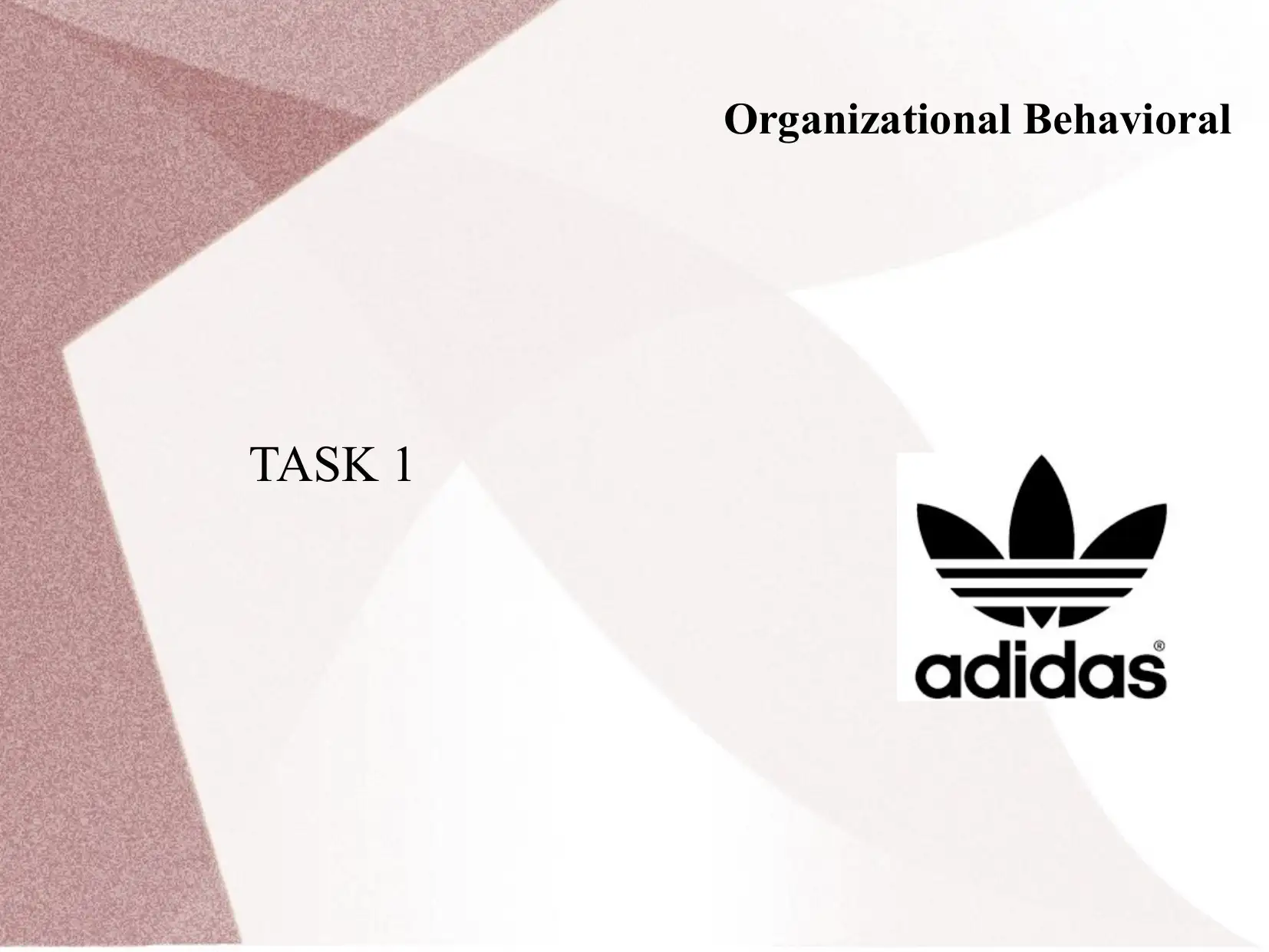
Organizational Behavioral
TASK 1
TASK 1
Secure Best Marks with AI Grader
Need help grading? Try our AI Grader for instant feedback on your assignments.
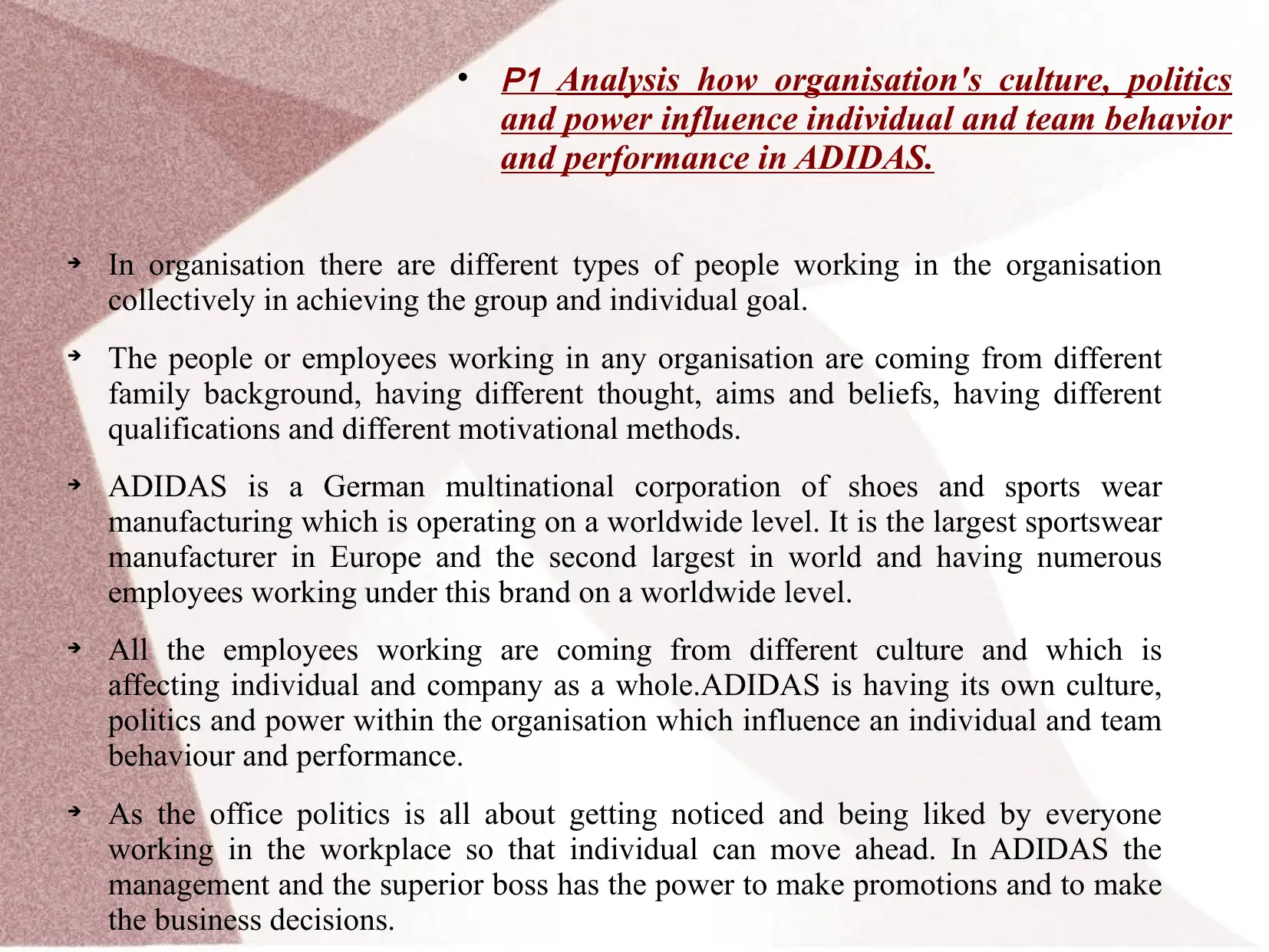
P1 Analysis how organisation's culture, politics
and power influence individual and team behavior
and performance in ADIDAS.
In organisation there are different types of people working in the organisation
collectively in achieving the group and individual goal.
The people or employees working in any organisation are coming from different
family background, having different thought, aims and beliefs, having different
qualifications and different motivational methods.
ADIDAS is a German multinational corporation of shoes and sports wear
manufacturing which is operating on a worldwide level. It is the largest sportswear
manufacturer in Europe and the second largest in world and having numerous
employees working under this brand on a worldwide level.
All the employees working are coming from different culture and which is
affecting individual and company as a whole.ADIDAS is having its own culture,
politics and power within the organisation which influence an individual and team
behaviour and performance.
As the office politics is all about getting noticed and being liked by everyone
working in the workplace so that individual can move ahead. In ADIDAS the
management and the superior boss has the power to make promotions and to make
the business decisions.
P1 Analysis how organisation's culture, politics
and power influence individual and team behavior
and performance in ADIDAS.
In organisation there are different types of people working in the organisation
collectively in achieving the group and individual goal.
The people or employees working in any organisation are coming from different
family background, having different thought, aims and beliefs, having different
qualifications and different motivational methods.
ADIDAS is a German multinational corporation of shoes and sports wear
manufacturing which is operating on a worldwide level. It is the largest sportswear
manufacturer in Europe and the second largest in world and having numerous
employees working under this brand on a worldwide level.
All the employees working are coming from different culture and which is
affecting individual and company as a whole.ADIDAS is having its own culture,
politics and power within the organisation which influence an individual and team
behaviour and performance.
As the office politics is all about getting noticed and being liked by everyone
working in the workplace so that individual can move ahead. In ADIDAS the
management and the superior boss has the power to make promotions and to make
the business decisions.
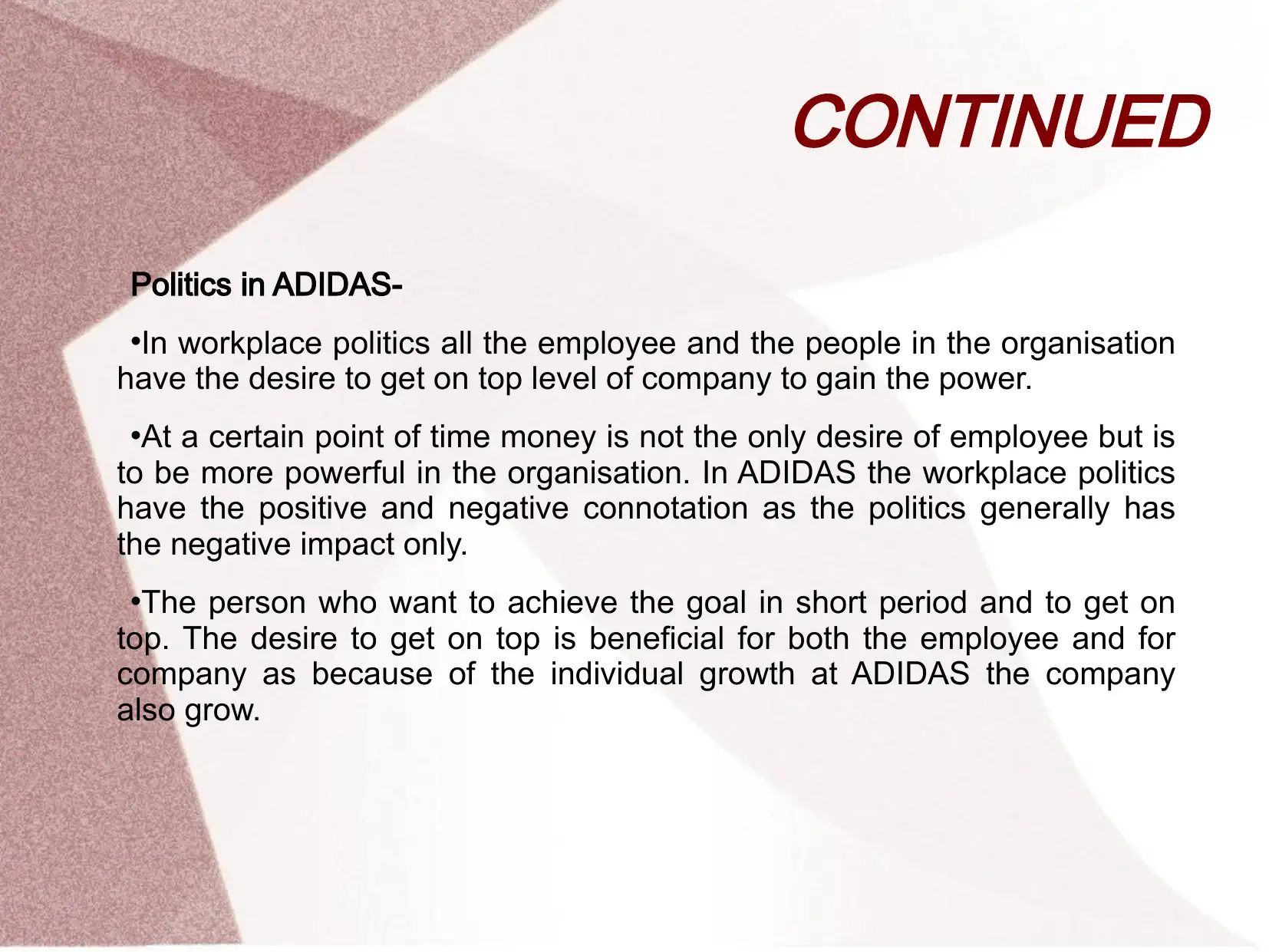
CONTINUED
Politics in ADIDAS-
In workplace politics all the employee and the people in the organisation
have the desire to get on top level of company to gain the power.
At a certain point of time money is not the only desire of employee but is
to be more powerful in the organisation. In ADIDAS the workplace politics
have the positive and negative connotation as the politics generally has
the negative impact only.
The person who want to achieve the goal in short period and to get on
top. The desire to get on top is beneficial for both the employee and for
company as because of the individual growth at ADIDAS the company
also grow.
Politics in ADIDAS-
In workplace politics all the employee and the people in the organisation
have the desire to get on top level of company to gain the power.
At a certain point of time money is not the only desire of employee but is
to be more powerful in the organisation. In ADIDAS the workplace politics
have the positive and negative connotation as the politics generally has
the negative impact only.
The person who want to achieve the goal in short period and to get on
top. The desire to get on top is beneficial for both the employee and for
company as because of the individual growth at ADIDAS the company
also grow.
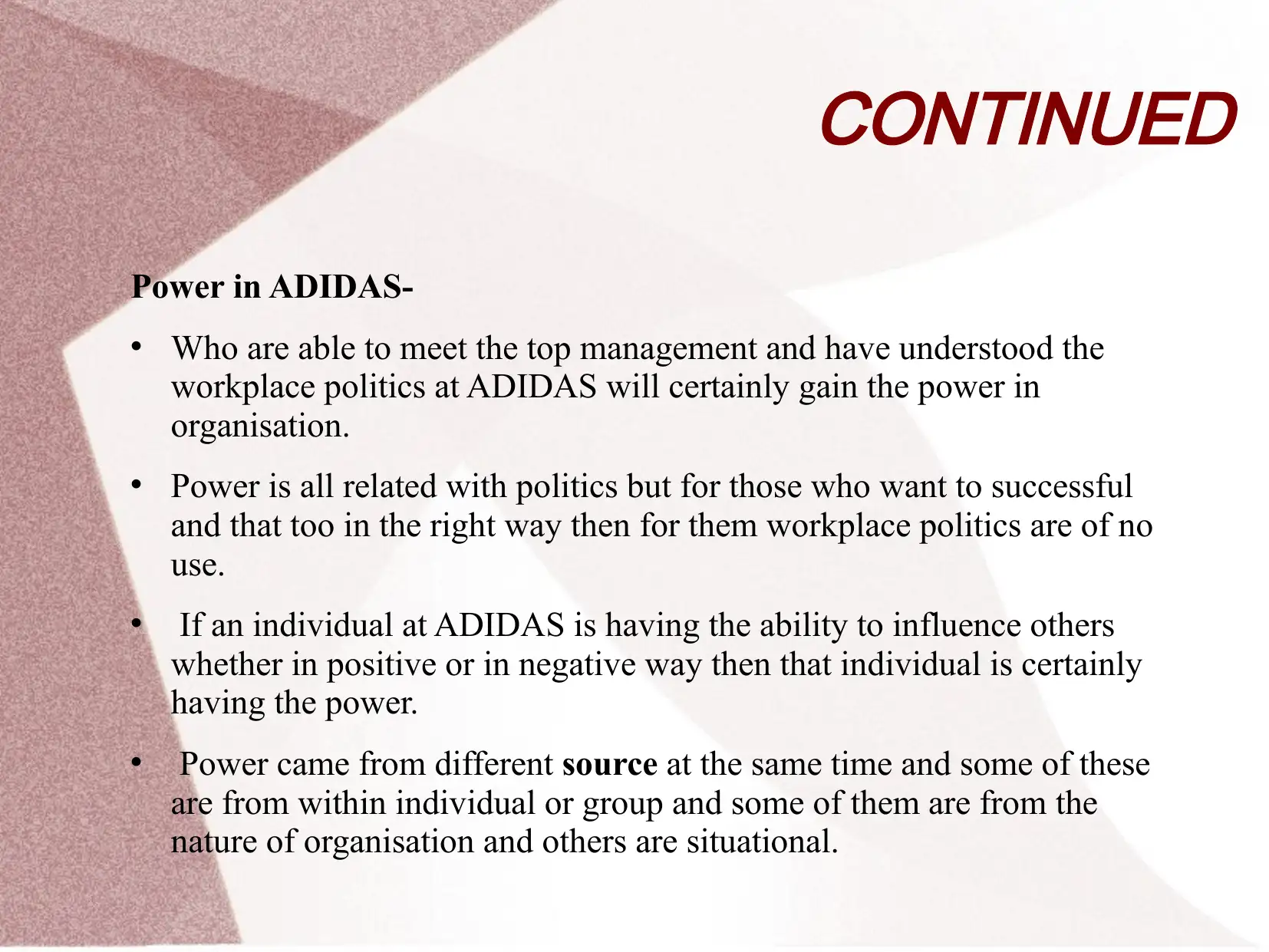
CONTINUED
Power in ADIDAS-
Who are able to meet the top management and have understood the
workplace politics at ADIDAS will certainly gain the power in
organisation.
Power is all related with politics but for those who want to successful
and that too in the right way then for them workplace politics are of no
use.
If an individual at ADIDAS is having the ability to influence others
whether in positive or in negative way then that individual is certainly
having the power.
Power came from different source at the same time and some of these
are from within individual or group and some of them are from the
nature of organisation and others are situational.
Power in ADIDAS-
Who are able to meet the top management and have understood the
workplace politics at ADIDAS will certainly gain the power in
organisation.
Power is all related with politics but for those who want to successful
and that too in the right way then for them workplace politics are of no
use.
If an individual at ADIDAS is having the ability to influence others
whether in positive or in negative way then that individual is certainly
having the power.
Power came from different source at the same time and some of these
are from within individual or group and some of them are from the
nature of organisation and others are situational.
Secure Best Marks with AI Grader
Need help grading? Try our AI Grader for instant feedback on your assignments.
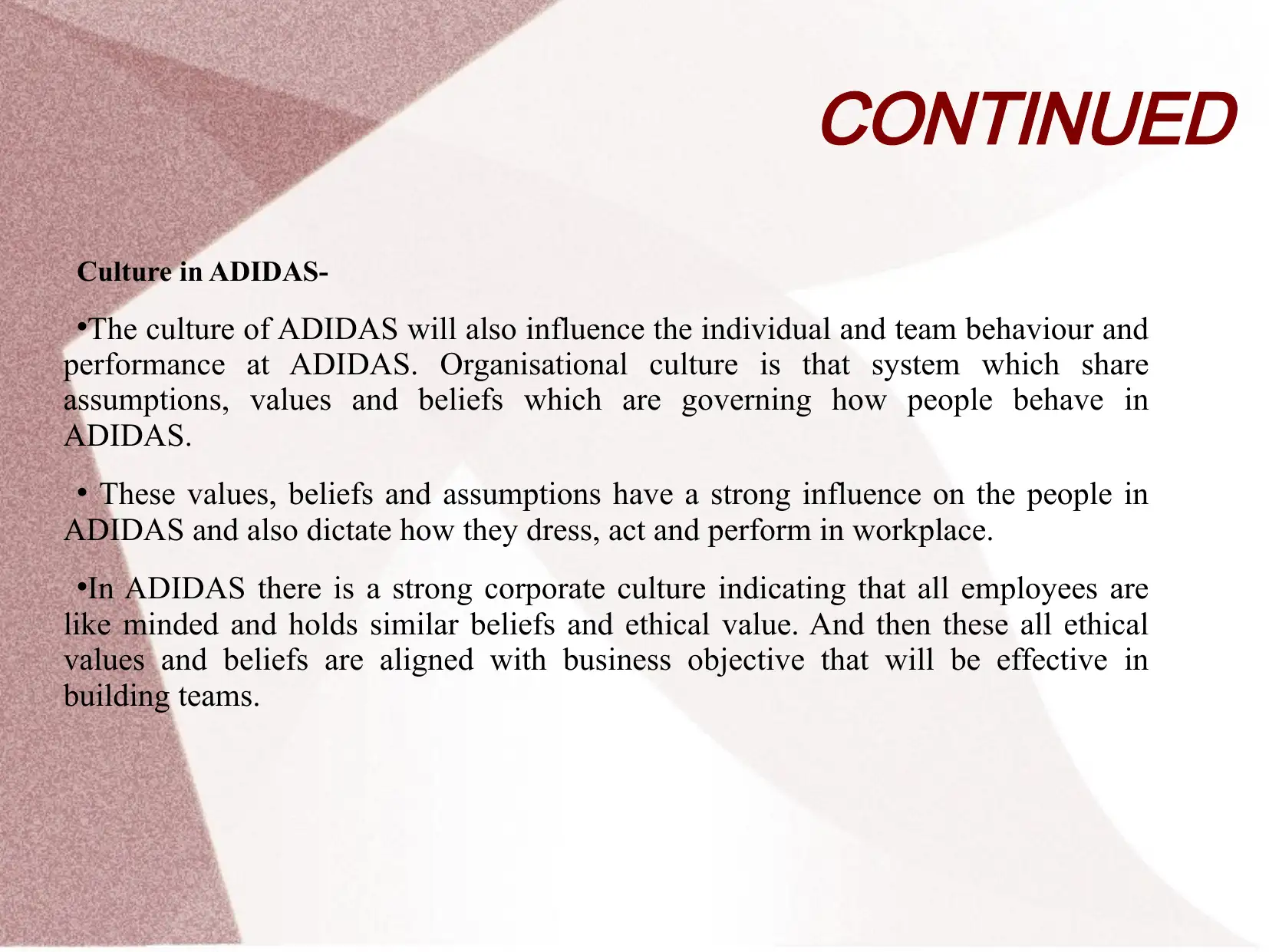
CONTINUED
Culture in ADIDAS-
The culture of ADIDAS will also influence the individual and team behaviour and
performance at ADIDAS. Organisational culture is that system which share
assumptions, values and beliefs which are governing how people behave in
ADIDAS.
These values, beliefs and assumptions have a strong influence on the people in
ADIDAS and also dictate how they dress, act and perform in workplace.
In ADIDAS there is a strong corporate culture indicating that all employees are
like minded and holds similar beliefs and ethical value. And then these all ethical
values and beliefs are aligned with business objective that will be effective in
building teams.
Culture in ADIDAS-
The culture of ADIDAS will also influence the individual and team behaviour and
performance at ADIDAS. Organisational culture is that system which share
assumptions, values and beliefs which are governing how people behave in
ADIDAS.
These values, beliefs and assumptions have a strong influence on the people in
ADIDAS and also dictate how they dress, act and perform in workplace.
In ADIDAS there is a strong corporate culture indicating that all employees are
like minded and holds similar beliefs and ethical value. And then these all ethical
values and beliefs are aligned with business objective that will be effective in
building teams.
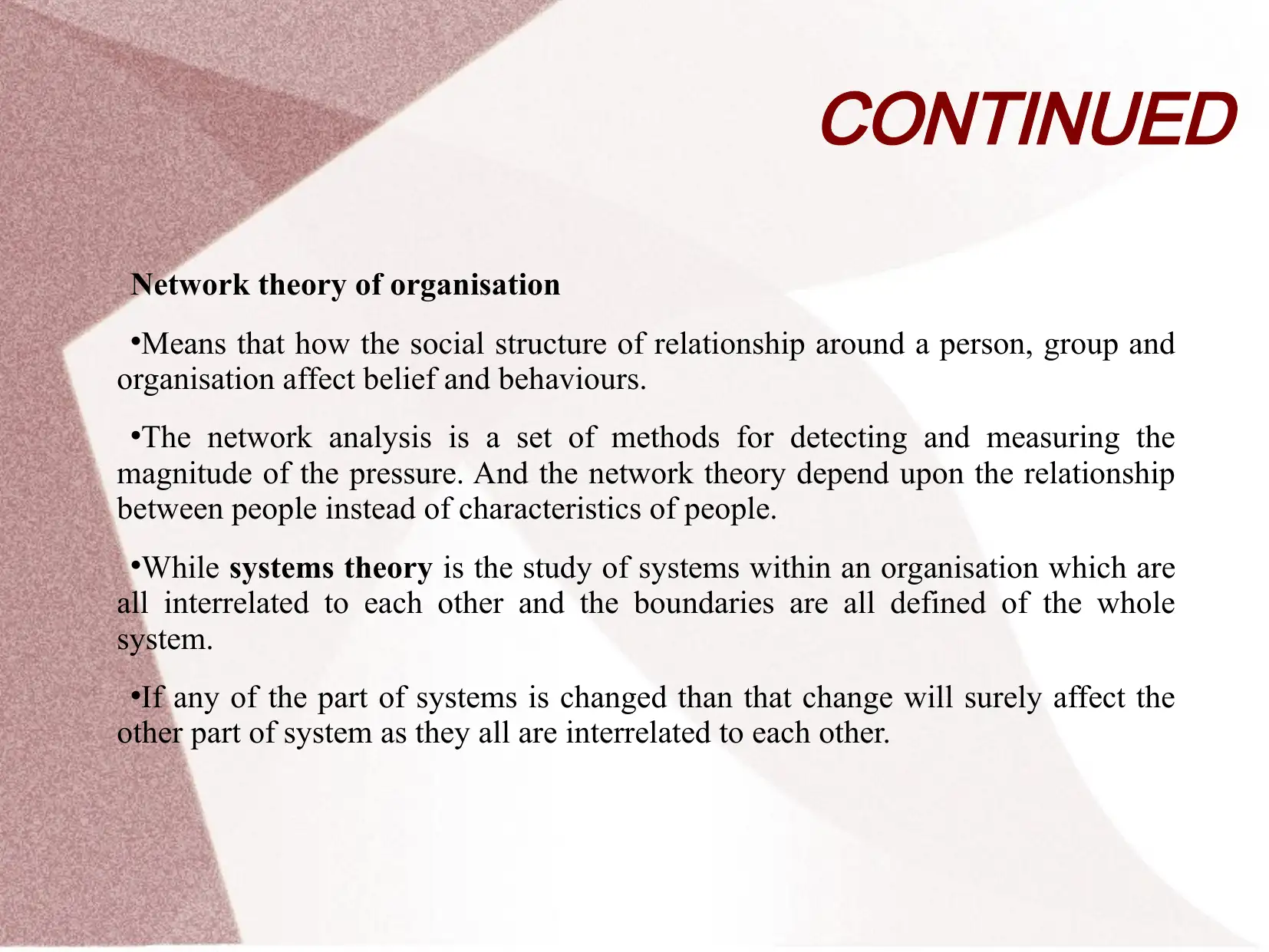
CONTINUED
Network theory of organisation
Means that how the social structure of relationship around a person, group and
organisation affect belief and behaviours.
The network analysis is a set of methods for detecting and measuring the
magnitude of the pressure. And the network theory depend upon the relationship
between people instead of characteristics of people.
While systems theory is the study of systems within an organisation which are
all interrelated to each other and the boundaries are all defined of the whole
system.
If any of the part of systems is changed than that change will surely affect the
other part of system as they all are interrelated to each other.
Network theory of organisation
Means that how the social structure of relationship around a person, group and
organisation affect belief and behaviours.
The network analysis is a set of methods for detecting and measuring the
magnitude of the pressure. And the network theory depend upon the relationship
between people instead of characteristics of people.
While systems theory is the study of systems within an organisation which are
all interrelated to each other and the boundaries are all defined of the whole
system.
If any of the part of systems is changed than that change will surely affect the
other part of system as they all are interrelated to each other.
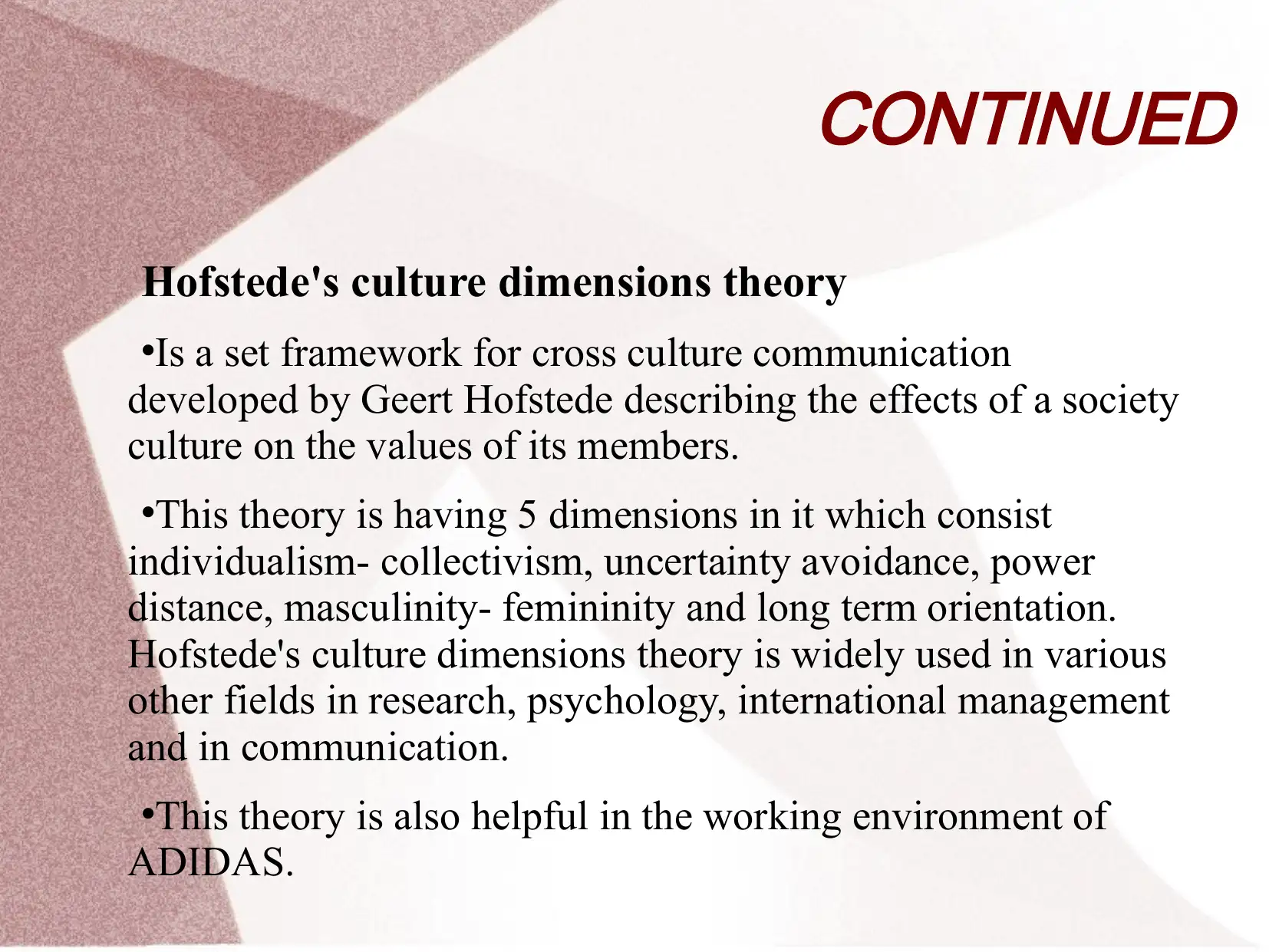
CONTINUED
Hofstede's culture dimensions theory
Is a set framework for cross culture communication
developed by Geert Hofstede describing the effects of a society
culture on the values of its members.
This theory is having 5 dimensions in it which consist
individualism- collectivism, uncertainty avoidance, power
distance, masculinity- femininity and long term orientation.
Hofstede's culture dimensions theory is widely used in various
other fields in research, psychology, international management
and in communication.
This theory is also helpful in the working environment of
ADIDAS.
Hofstede's culture dimensions theory
Is a set framework for cross culture communication
developed by Geert Hofstede describing the effects of a society
culture on the values of its members.
This theory is having 5 dimensions in it which consist
individualism- collectivism, uncertainty avoidance, power
distance, masculinity- femininity and long term orientation.
Hofstede's culture dimensions theory is widely used in various
other fields in research, psychology, international management
and in communication.
This theory is also helpful in the working environment of
ADIDAS.
Paraphrase This Document
Need a fresh take? Get an instant paraphrase of this document with our AI Paraphraser
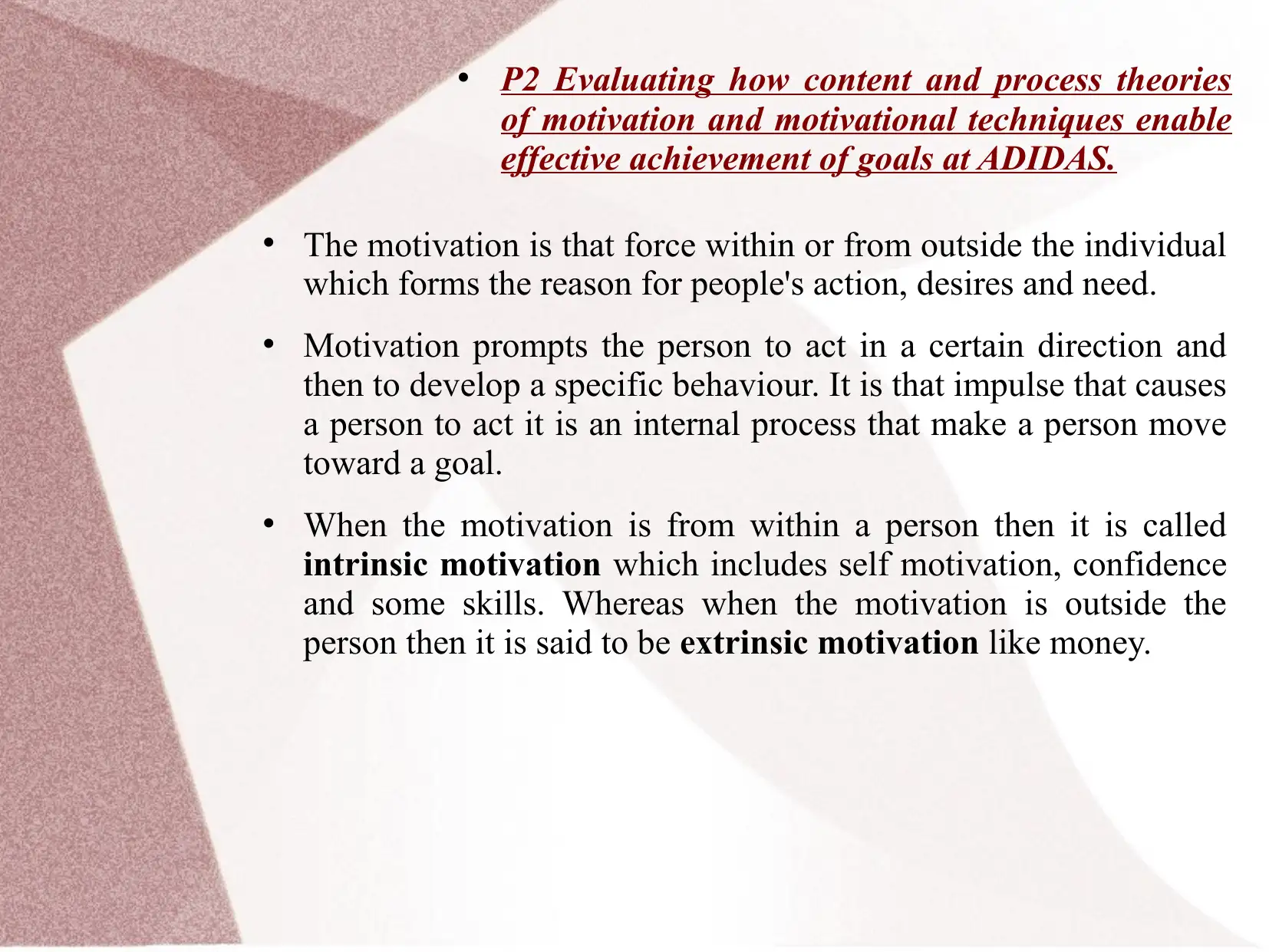
P2 Evaluating how content and process theories
of motivation and motivational techniques enable
effective achievement of goals at ADIDAS.
The motivation is that force within or from outside the individual
which forms the reason for people's action, desires and need.
Motivation prompts the person to act in a certain direction and
then to develop a specific behaviour. It is that impulse that causes
a person to act it is an internal process that make a person move
toward a goal.
When the motivation is from within a person then it is called
intrinsic motivation which includes self motivation, confidence
and some skills. Whereas when the motivation is outside the
person then it is said to be extrinsic motivation like money.
of motivation and motivational techniques enable
effective achievement of goals at ADIDAS.
The motivation is that force within or from outside the individual
which forms the reason for people's action, desires and need.
Motivation prompts the person to act in a certain direction and
then to develop a specific behaviour. It is that impulse that causes
a person to act it is an internal process that make a person move
toward a goal.
When the motivation is from within a person then it is called
intrinsic motivation which includes self motivation, confidence
and some skills. Whereas when the motivation is outside the
person then it is said to be extrinsic motivation like money.
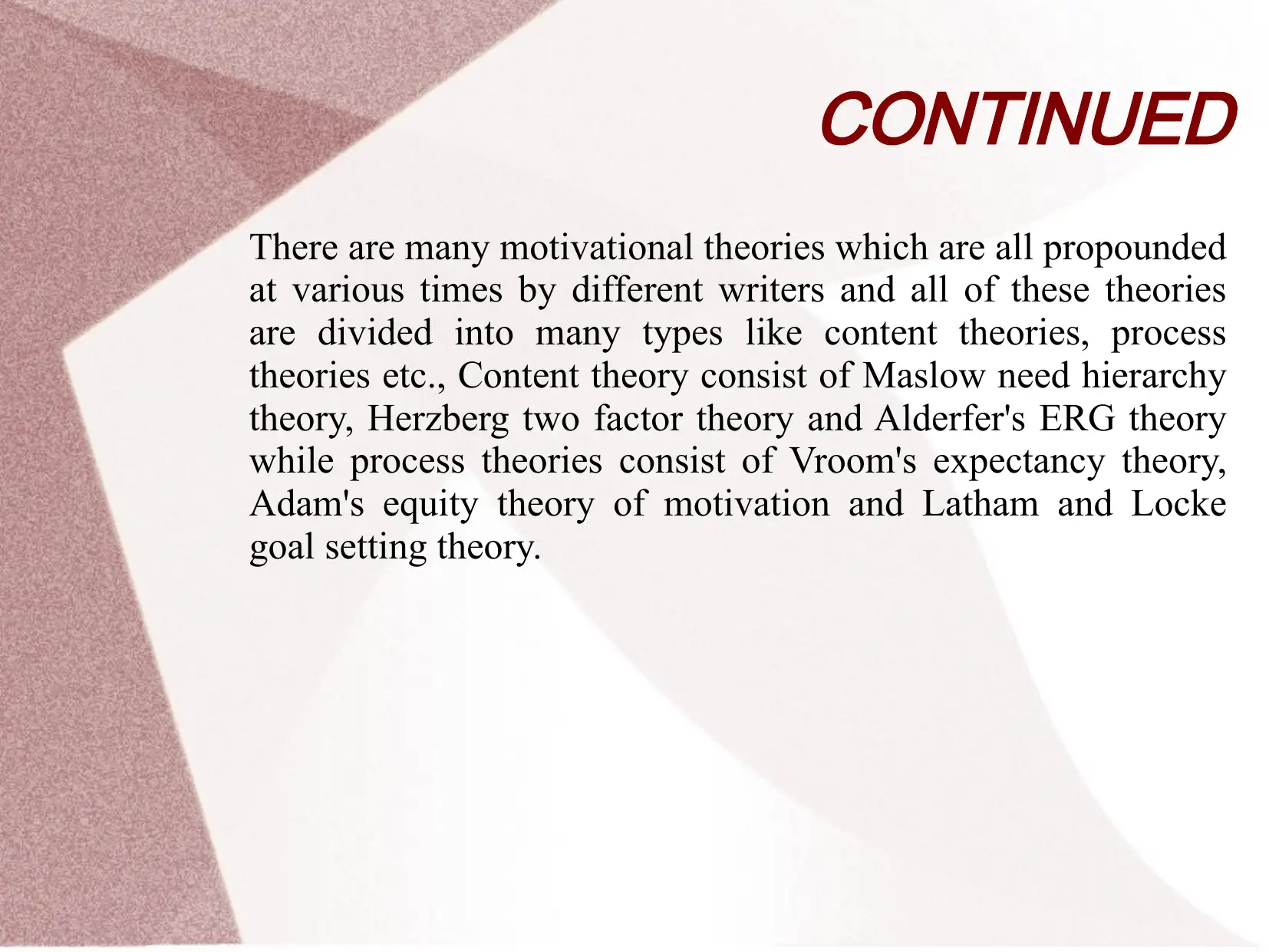
CONTINUED
There are many motivational theories which are all propounded
at various times by different writers and all of these theories
are divided into many types like content theories, process
theories etc., Content theory consist of Maslow need hierarchy
theory, Herzberg two factor theory and Alderfer's ERG theory
while process theories consist of Vroom's expectancy theory,
Adam's equity theory of motivation and Latham and Locke
goal setting theory.
There are many motivational theories which are all propounded
at various times by different writers and all of these theories
are divided into many types like content theories, process
theories etc., Content theory consist of Maslow need hierarchy
theory, Herzberg two factor theory and Alderfer's ERG theory
while process theories consist of Vroom's expectancy theory,
Adam's equity theory of motivation and Latham and Locke
goal setting theory.
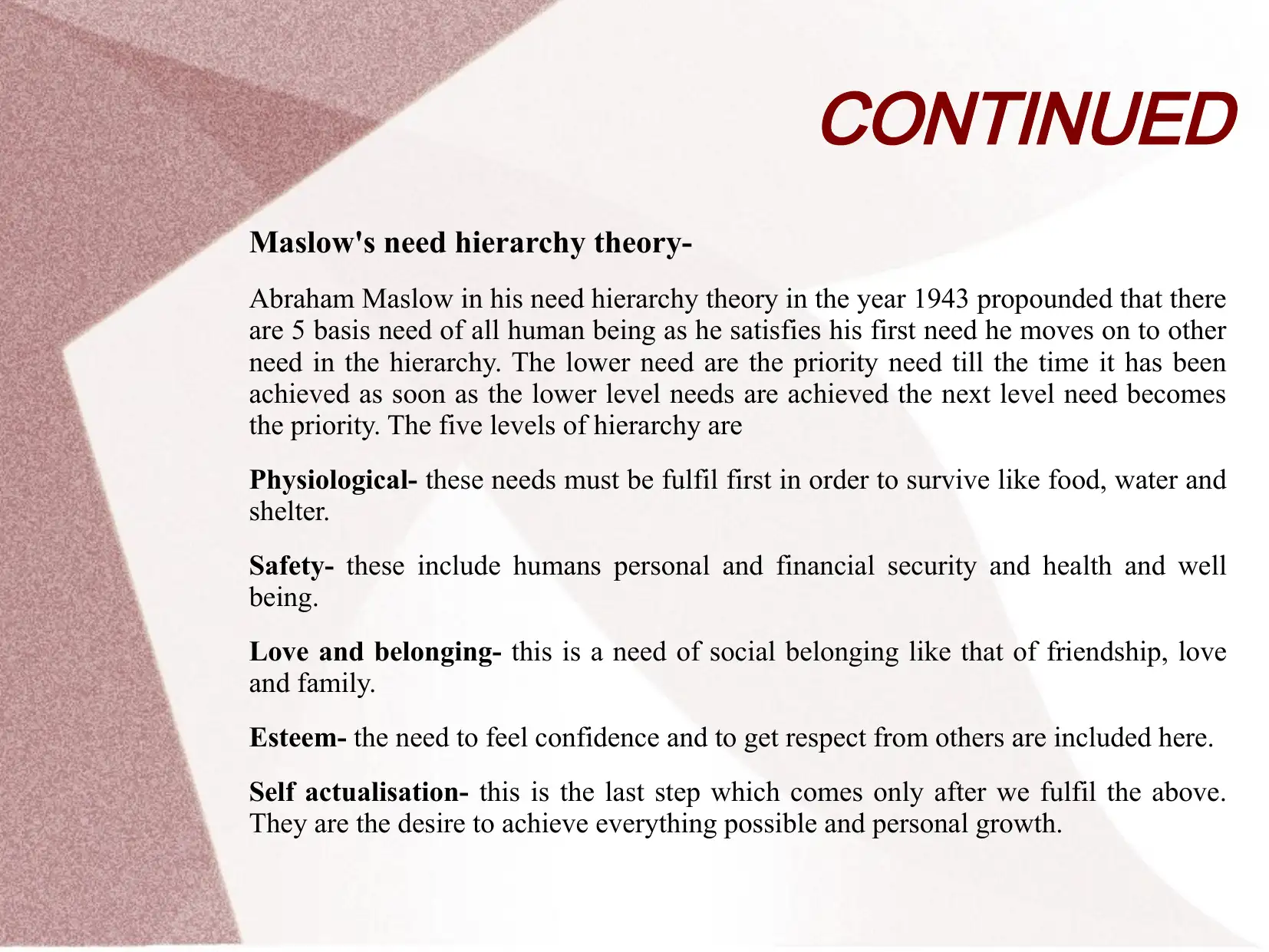
CONTINUED
Maslow's need hierarchy theory-
Abraham Maslow in his need hierarchy theory in the year 1943 propounded that there
are 5 basis need of all human being as he satisfies his first need he moves on to other
need in the hierarchy. The lower need are the priority need till the time it has been
achieved as soon as the lower level needs are achieved the next level need becomes
the priority. The five levels of hierarchy are
Physiological- these needs must be fulfil first in order to survive like food, water and
shelter.
Safety- these include humans personal and financial security and health and well
being.
Love and belonging- this is a need of social belonging like that of friendship, love
and family.
Esteem- the need to feel confidence and to get respect from others are included here.
Self actualisation- this is the last step which comes only after we fulfil the above.
They are the desire to achieve everything possible and personal growth.
Maslow's need hierarchy theory-
Abraham Maslow in his need hierarchy theory in the year 1943 propounded that there
are 5 basis need of all human being as he satisfies his first need he moves on to other
need in the hierarchy. The lower need are the priority need till the time it has been
achieved as soon as the lower level needs are achieved the next level need becomes
the priority. The five levels of hierarchy are
Physiological- these needs must be fulfil first in order to survive like food, water and
shelter.
Safety- these include humans personal and financial security and health and well
being.
Love and belonging- this is a need of social belonging like that of friendship, love
and family.
Esteem- the need to feel confidence and to get respect from others are included here.
Self actualisation- this is the last step which comes only after we fulfil the above.
They are the desire to achieve everything possible and personal growth.
Secure Best Marks with AI Grader
Need help grading? Try our AI Grader for instant feedback on your assignments.
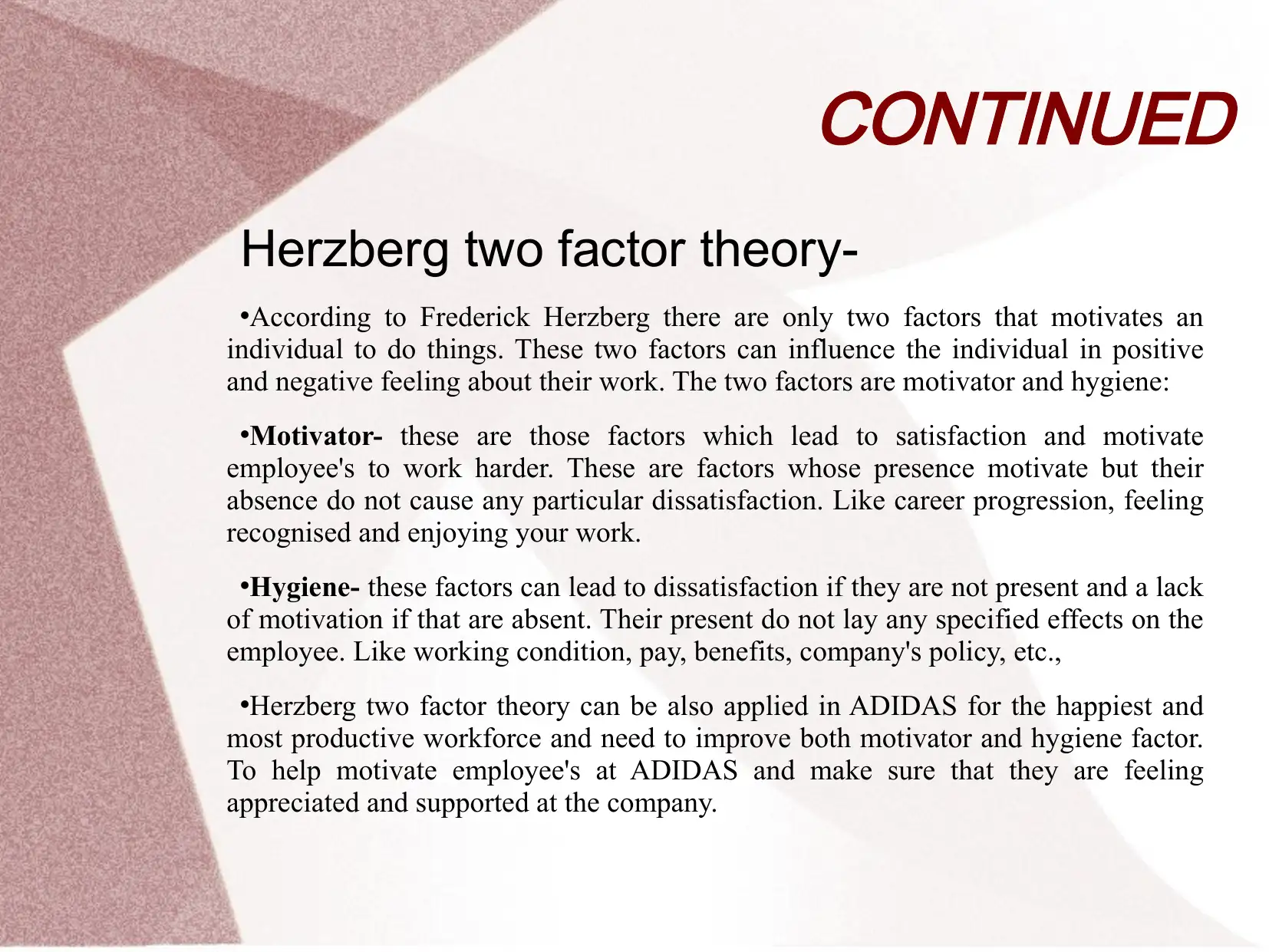
CONTINUED
Herzberg two factor theory-
According to Frederick Herzberg there are only two factors that motivates an
individual to do things. These two factors can influence the individual in positive
and negative feeling about their work. The two factors are motivator and hygiene:
Motivator- these are those factors which lead to satisfaction and motivate
employee's to work harder. These are factors whose presence motivate but their
absence do not cause any particular dissatisfaction. Like career progression, feeling
recognised and enjoying your work.
Hygiene- these factors can lead to dissatisfaction if they are not present and a lack
of motivation if that are absent. Their present do not lay any specified effects on the
employee. Like working condition, pay, benefits, company's policy, etc.,
Herzberg two factor theory can be also applied in ADIDAS for the happiest and
most productive workforce and need to improve both motivator and hygiene factor.
To help motivate employee's at ADIDAS and make sure that they are feeling
appreciated and supported at the company.
Herzberg two factor theory-
According to Frederick Herzberg there are only two factors that motivates an
individual to do things. These two factors can influence the individual in positive
and negative feeling about their work. The two factors are motivator and hygiene:
Motivator- these are those factors which lead to satisfaction and motivate
employee's to work harder. These are factors whose presence motivate but their
absence do not cause any particular dissatisfaction. Like career progression, feeling
recognised and enjoying your work.
Hygiene- these factors can lead to dissatisfaction if they are not present and a lack
of motivation if that are absent. Their present do not lay any specified effects on the
employee. Like working condition, pay, benefits, company's policy, etc.,
Herzberg two factor theory can be also applied in ADIDAS for the happiest and
most productive workforce and need to improve both motivator and hygiene factor.
To help motivate employee's at ADIDAS and make sure that they are feeling
appreciated and supported at the company.
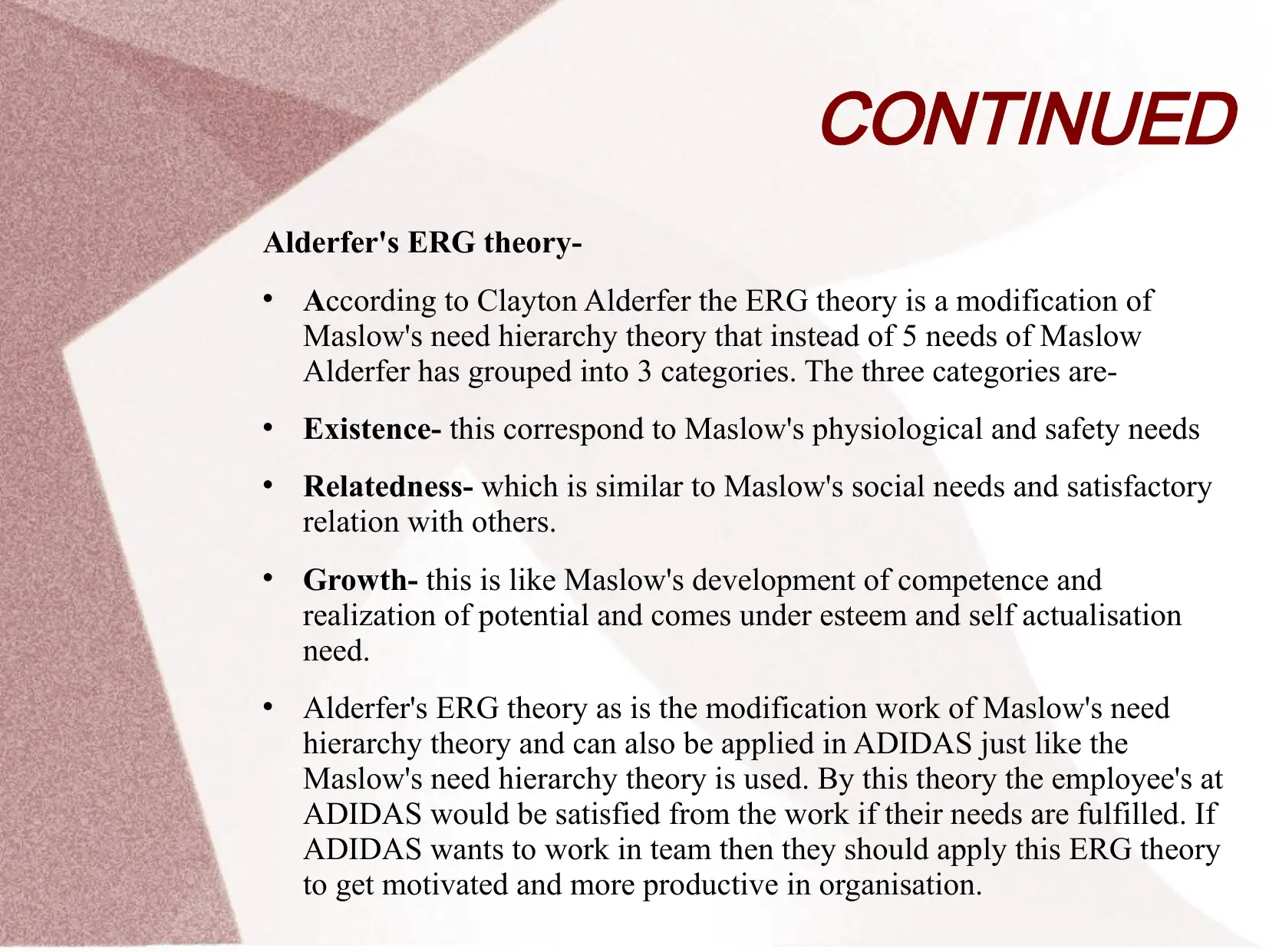
CONTINUED
Alderfer's ERG theory-
According to Clayton Alderfer the ERG theory is a modification of
Maslow's need hierarchy theory that instead of 5 needs of Maslow
Alderfer has grouped into 3 categories. The three categories are-
Existence- this correspond to Maslow's physiological and safety needs
Relatedness- which is similar to Maslow's social needs and satisfactory
relation with others.
Growth- this is like Maslow's development of competence and
realization of potential and comes under esteem and self actualisation
need.
Alderfer's ERG theory as is the modification work of Maslow's need
hierarchy theory and can also be applied in ADIDAS just like the
Maslow's need hierarchy theory is used. By this theory the employee's at
ADIDAS would be satisfied from the work if their needs are fulfilled. If
ADIDAS wants to work in team then they should apply this ERG theory
to get motivated and more productive in organisation.
Alderfer's ERG theory-
According to Clayton Alderfer the ERG theory is a modification of
Maslow's need hierarchy theory that instead of 5 needs of Maslow
Alderfer has grouped into 3 categories. The three categories are-
Existence- this correspond to Maslow's physiological and safety needs
Relatedness- which is similar to Maslow's social needs and satisfactory
relation with others.
Growth- this is like Maslow's development of competence and
realization of potential and comes under esteem and self actualisation
need.
Alderfer's ERG theory as is the modification work of Maslow's need
hierarchy theory and can also be applied in ADIDAS just like the
Maslow's need hierarchy theory is used. By this theory the employee's at
ADIDAS would be satisfied from the work if their needs are fulfilled. If
ADIDAS wants to work in team then they should apply this ERG theory
to get motivated and more productive in organisation.
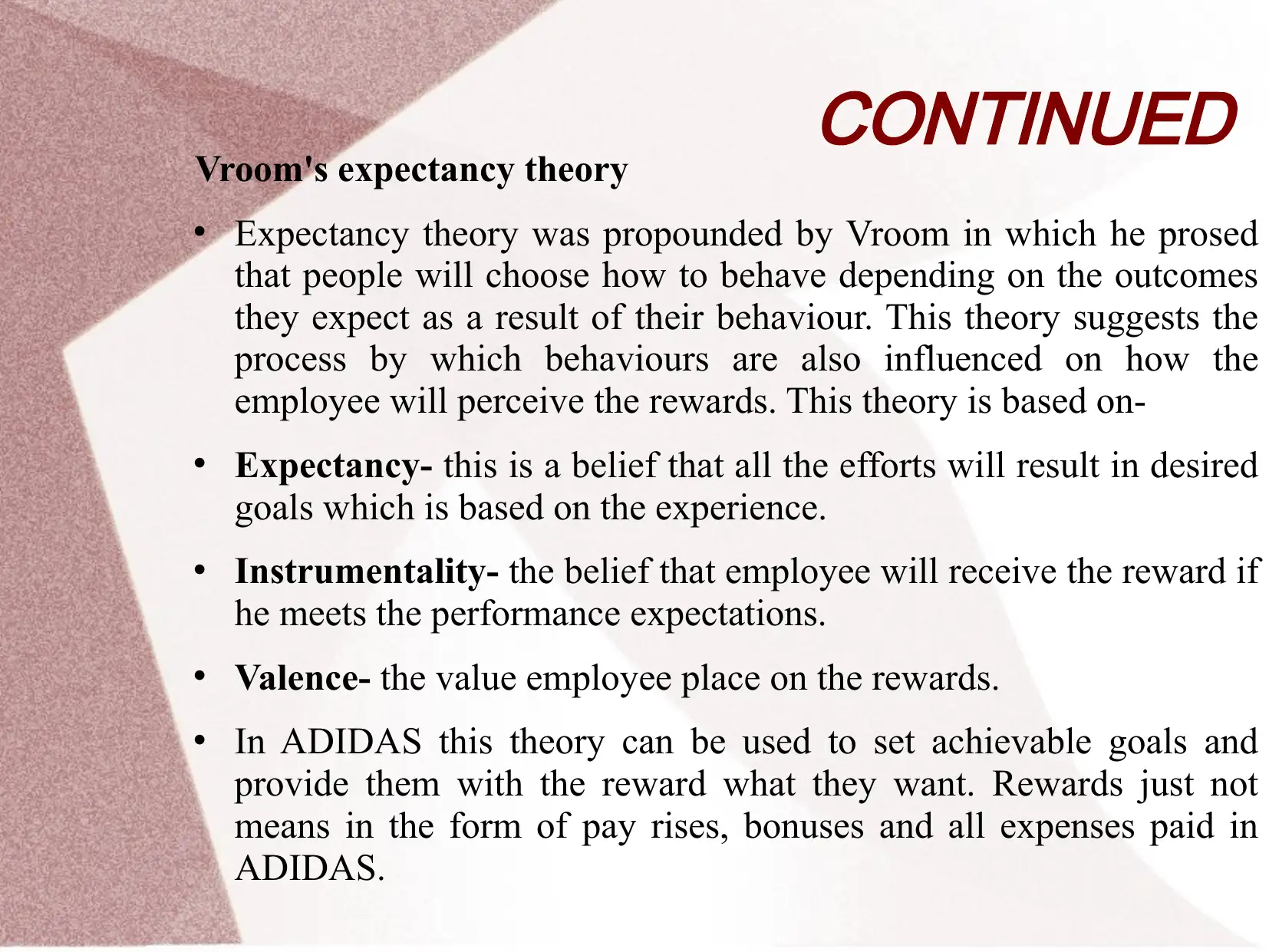
CONTINUED
Vroom's expectancy theory
Expectancy theory was propounded by Vroom in which he prosed
that people will choose how to behave depending on the outcomes
they expect as a result of their behaviour. This theory suggests the
process by which behaviours are also influenced on how the
employee will perceive the rewards. This theory is based on-
Expectancy- this is a belief that all the efforts will result in desired
goals which is based on the experience.
Instrumentality- the belief that employee will receive the reward if
he meets the performance expectations.
Valence- the value employee place on the rewards.
In ADIDAS this theory can be used to set achievable goals and
provide them with the reward what they want. Rewards just not
means in the form of pay rises, bonuses and all expenses paid in
ADIDAS.
Vroom's expectancy theory
Expectancy theory was propounded by Vroom in which he prosed
that people will choose how to behave depending on the outcomes
they expect as a result of their behaviour. This theory suggests the
process by which behaviours are also influenced on how the
employee will perceive the rewards. This theory is based on-
Expectancy- this is a belief that all the efforts will result in desired
goals which is based on the experience.
Instrumentality- the belief that employee will receive the reward if
he meets the performance expectations.
Valence- the value employee place on the rewards.
In ADIDAS this theory can be used to set achievable goals and
provide them with the reward what they want. Rewards just not
means in the form of pay rises, bonuses and all expenses paid in
ADIDAS.
Paraphrase This Document
Need a fresh take? Get an instant paraphrase of this document with our AI Paraphraser
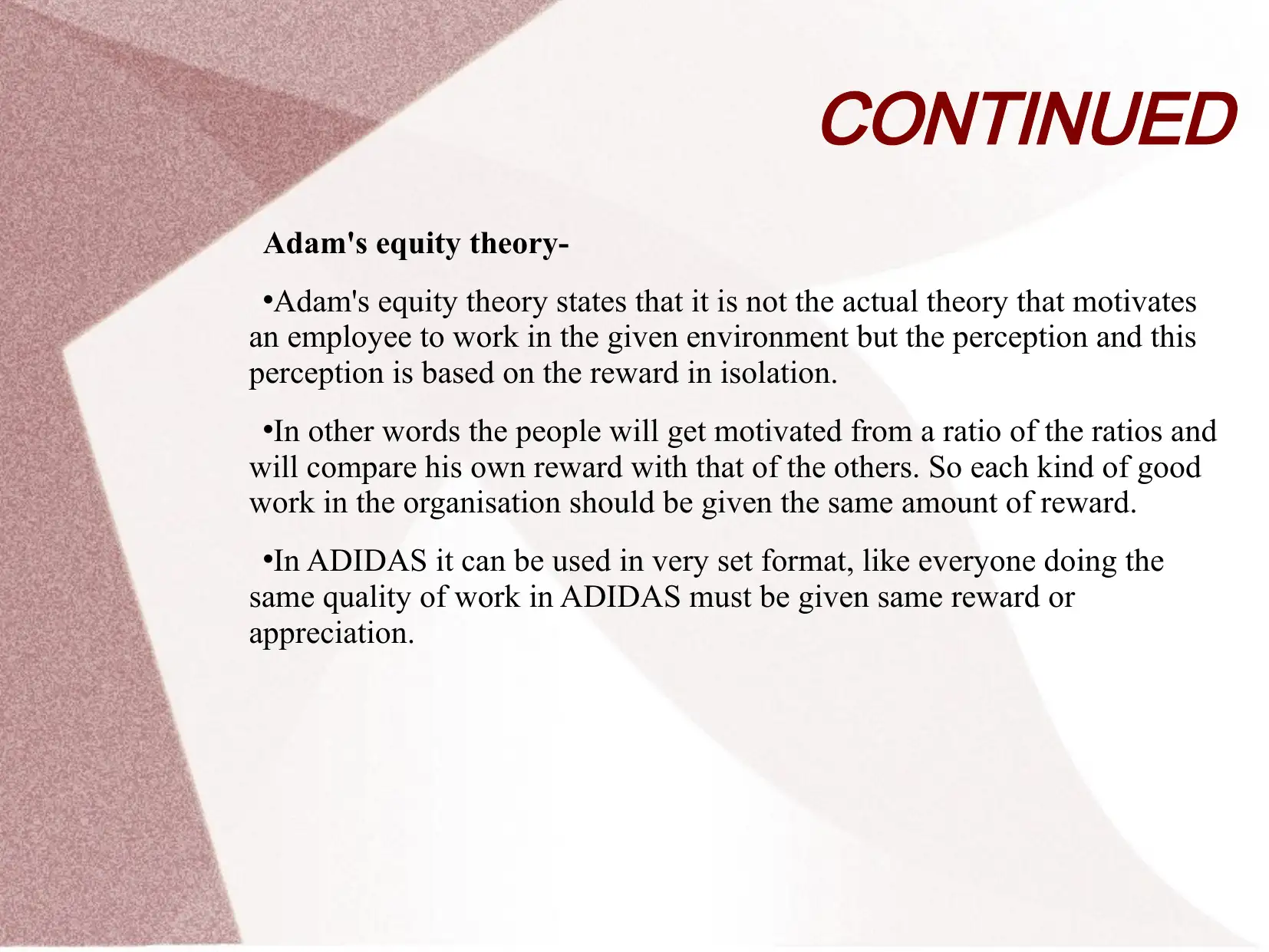
CONTINUED
Adam's equity theory-
Adam's equity theory states that it is not the actual theory that motivates
an employee to work in the given environment but the perception and this
perception is based on the reward in isolation.
In other words the people will get motivated from a ratio of the ratios and
will compare his own reward with that of the others. So each kind of good
work in the organisation should be given the same amount of reward.
In ADIDAS it can be used in very set format, like everyone doing the
same quality of work in ADIDAS must be given same reward or
appreciation.
Adam's equity theory-
Adam's equity theory states that it is not the actual theory that motivates
an employee to work in the given environment but the perception and this
perception is based on the reward in isolation.
In other words the people will get motivated from a ratio of the ratios and
will compare his own reward with that of the others. So each kind of good
work in the organisation should be given the same amount of reward.
In ADIDAS it can be used in very set format, like everyone doing the
same quality of work in ADIDAS must be given same reward or
appreciation.
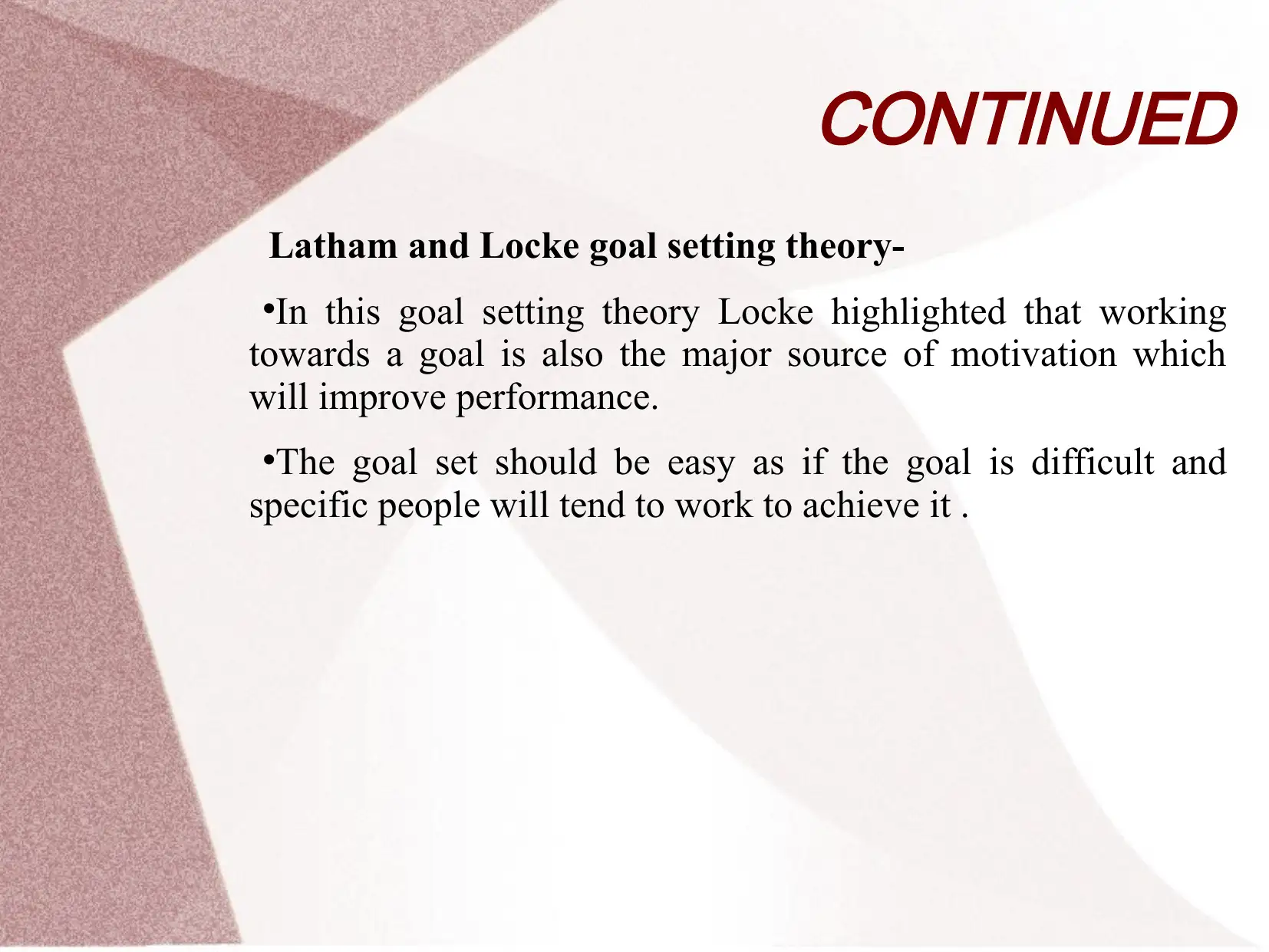
CONTINUED
Latham and Locke goal setting theory-
In this goal setting theory Locke highlighted that working
towards a goal is also the major source of motivation which
will improve performance.
The goal set should be easy as if the goal is difficult and
specific people will tend to work to achieve it .
Latham and Locke goal setting theory-
In this goal setting theory Locke highlighted that working
towards a goal is also the major source of motivation which
will improve performance.
The goal set should be easy as if the goal is difficult and
specific people will tend to work to achieve it .
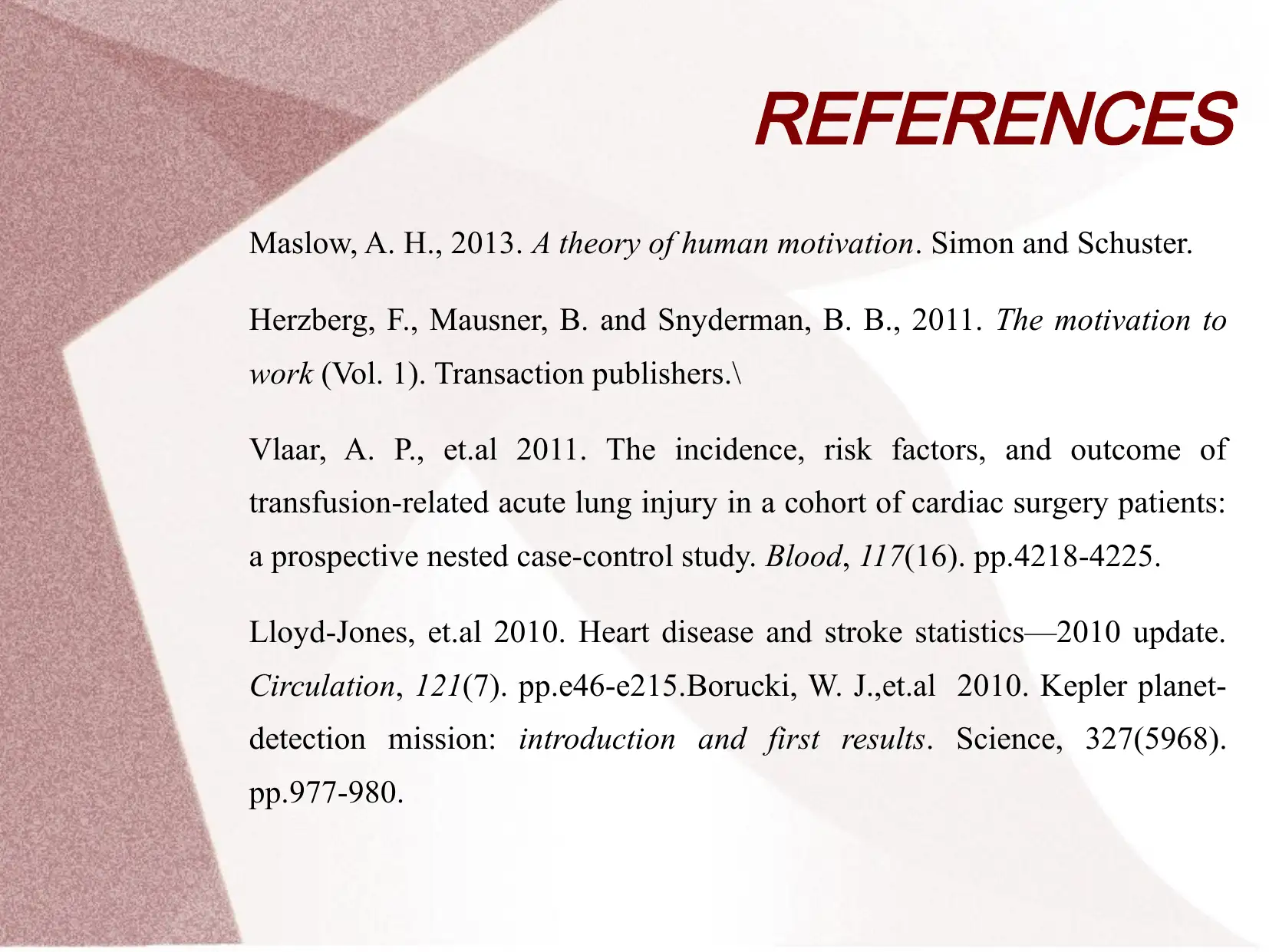
REFERENCES
Maslow, A. H., 2013. A theory of human motivation. Simon and Schuster.
Herzberg, F., Mausner, B. and Snyderman, B. B., 2011. The motivation to
work (Vol. 1). Transaction publishers.\
Vlaar, A. P., et.al 2011. The incidence, risk factors, and outcome of
transfusion-related acute lung injury in a cohort of cardiac surgery patients:
a prospective nested case-control study. Blood, 117(16). pp.4218-4225.
Lloyd-Jones, et.al 2010. Heart disease and stroke statistics—2010 update.
Circulation, 121(7). pp.e46-e215.Borucki, W. J.,et.al 2010. Kepler planet-
detection mission: introduction and first results. Science, 327(5968).
pp.977-980.
Maslow, A. H., 2013. A theory of human motivation. Simon and Schuster.
Herzberg, F., Mausner, B. and Snyderman, B. B., 2011. The motivation to
work (Vol. 1). Transaction publishers.\
Vlaar, A. P., et.al 2011. The incidence, risk factors, and outcome of
transfusion-related acute lung injury in a cohort of cardiac surgery patients:
a prospective nested case-control study. Blood, 117(16). pp.4218-4225.
Lloyd-Jones, et.al 2010. Heart disease and stroke statistics—2010 update.
Circulation, 121(7). pp.e46-e215.Borucki, W. J.,et.al 2010. Kepler planet-
detection mission: introduction and first results. Science, 327(5968).
pp.977-980.
1 out of 16
Related Documents
Your All-in-One AI-Powered Toolkit for Academic Success.
+13062052269
info@desklib.com
Available 24*7 on WhatsApp / Email
![[object Object]](/_next/static/media/star-bottom.7253800d.svg)
Unlock your academic potential
© 2024 | Zucol Services PVT LTD | All rights reserved.





